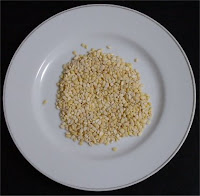
Since we’re all feeling the economic pinch these days and looking for ways to save a dollar (or even a penny), I figured I would post a cheap yet satisfying Ayurvedic recipe. My advice for reducing grocery bills (if you eat out, then you better learn to cook) is simple: eat less meat and choose fresh, unprocessed foods. Steer clear of “ready-to-eat” products or any type of meal preparation kit and you will find that your dollar goes a lot further. So far, in fact, that you will be able to afford all natural and organic foods as long as the recession lasts.
While not everyone is cut out to be a vegetarian (such as individuals with really strong appetites, whose constitutions are predominantly Pitta); most people can go a few days without consuming animal flesh. The most nutritionally balanced way to beat the meat habit is to gain an appreciation for beans and rice. The practice of combining grains and legumes to satisfy one’s hunger and fuel a labor-intensive lifestyle goes back to Biblical times. Today we know that the amino acids present in wheat, rice and other cereal grains complement those in beans and nuts. Humans need to consume a variety of plant-based foods to ensure dietary intake of all essential amino acids (the building blocks of protein that the body can not produce on its own).
While there are thousands of kinds of beans and lentils grown around the world, the mung bean is most esteemed in Ayurveda. Mung beans are easier to digest than other legumes and the only type that is tridoshic, or balancing for all three doshas. Split mung beans, also known as mung dal, are commonly incorporated into cleansing and restorative dishes. It is best to cook mung beans with warming spices to offset their slightly cooling effect. One of the most popular dishes made with mung dal is kitchari, a stew which brings together the best of Indian healing cuisine: fragrant basmati rice, mild mung dal and tantalizing spices. Fresh chiles, vegetables, curry leaves and cilantro may also be added to your liking. There are an infinite number of ways to prepare kitchari but I will share just one very simple, seasonally appropriate recipe for now.
If you have a pantry stocked with all the requisite spices, I estimated that each serving costs less than fifty cents. I recommend purchasing “real” basmati rice from India (not U.S.-grown “Texmati” rice). Don’t let the following long list of ingredients scare you - most are dried spices which you can mix together ahead of time to make your own homemade "curry powder" for use in other dishes.
Warming Winter Kitchari
serves about 3
¼ cup split mung dal
½ cup basmati rice
1- 2 Tablespoon ghee (more for individuals with Vata disorders)
½ teaspoon brown mustard seeds
½ teaspoon cumin seeds
1/8 teaspoon hing
¼ teaspoon ground cumin seeds*
¼ teaspoon ground coriander seeds*
¼ teaspoon ground fennel seeds*
½ teaspoon dry ginger
¼ teaspoon turmeric
¼ teaspoon fenugreek
1/8 teaspoon ground cinnamon
4 cups water
¾ teaspoon sea salt
¼ cup fresh chopped cilantro, for garnish
½ cup basmati rice
1- 2 Tablespoon ghee (more for individuals with Vata disorders)
½ teaspoon brown mustard seeds
½ teaspoon cumin seeds
1/8 teaspoon hing
¼ teaspoon ground cumin seeds*
¼ teaspoon ground coriander seeds*
¼ teaspoon ground fennel seeds*
½ teaspoon dry ginger
¼ teaspoon turmeric
¼ teaspoon fenugreek
1/8 teaspoon ground cinnamon
4 cups water
¾ teaspoon sea salt
¼ cup fresh chopped cilantro, for garnish
1. Rinse dal and rice under cool water until water runs clear. Set aside to drain well.
2. Heat ghee in a 2 to 3 quart-sized saucepan over medium-high heat and add mustard seeds, cumin seeds and hing. Cook until seeds begin to pop.
3. Turn down heat and add remaining spices. Cook a minute, stirring, until fragrant (be careful not to burn, remove pan from heat if necessary).
4. Add rinsed dal and rice to cooked spice mixture. Add water and bring to a boil. Reduce heat to low and simmer gently, covered, for 45 minutes to an hour. In last 20 minutes of cooking, stir occasionally to prevent kitchari from sticking to bottom of pan.
5. Stir in salt, cover and allow kitchari to rest 5 - 10 minutes before serving.
Serve kitchari garnished with fresh chopped cilantro.
* I recommend toasting and grinding seeds yourself, but store bought pre-ground seeds will also work.





No comments:
Post a Comment